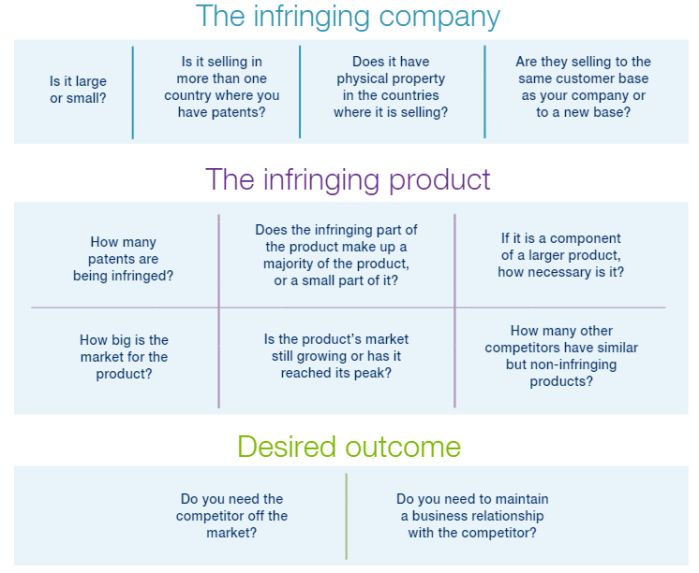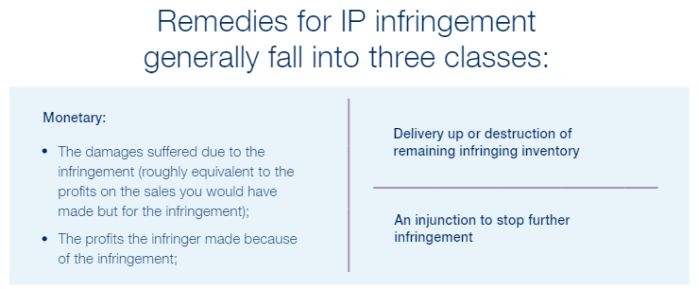- with Finance and Tax Executives
- with readers working within the Banking & Credit, Insurance and Healthcare industries
Enforcing and protecting intellectual property (IP) is crucial for any business. In this latest article in our IP Asset series, we discuss enforcing your intellectual property through a hypothetical head of IP explaining to their boss how the portfolio can be used.
Taylor is in charge of IP at an SME (small or medium enterprise). They have been strategic in their filings, trying to cover both their commercial product and the competitive space. Up until now, the IP department has been a cost centre - not adding to the SME's profit, but costing money to run it. Taylor recently learned that some of their issued patents covering key technologies are being infringed.
What do you do when someone infringes your IP rights?
Taylor worked to get the patents issued and has spent some time justifying that cost. Now that the patents are being infringed, Taylor sees an opportunity to show the value of the patents.
IP is a private property right. However, the fact that a company has a trademark, patent, or other IP does not prevent someone else from infringing it - and a third party is not going to step in and stop them. In the same way that a property owner must take steps to stop someone from trespassing on their physical property, an intellectual property owner must take steps to stop someone from infringing their IP.
The ways in which you can stop someone from infringing IP can take a number of forms, with varying costs and outcomes. In reviewing the patents being infringed, and the company doing the infringing, Taylor considers a number of factors:

By considering these factors, Taylor is able to focus on what is a need versus what is a want in the next steps of enforcement.
Example IP enforcement steps
Common steps taken in IP enforcement typically include cease and desist letters, litigation, and settlement.
Cease and desist letters
In most IP disputes, the first step is to send a letter.
A cease and desist letter lets the other party know they are doing something you think infringes your rights. This company may not be aware of your IP rights, or they may be aware and not care.
Taylor wants to make sure the infringer knows the company is taking its IP rights seriously. But in doing so, Taylor is careful not to make unfounded threats. In particular, threats should not be made to clients of the infringer.
The tone of these letters can range from informative to threatening, although most letters fall somewhere in between. The factors and desired outcomes set out above determine the tone of the letter. If the goal is to get them to stop selling, a stronger tone may be necessary. If the goal is to start licence negotiations, a softer tone may be desired.
If Taylor needs them off the market as part of the company's strategic plan, the tone of the letter is less important than sending it to give notice. In such cases, the letter may prompt a change in the other company's product, or an attempt at negotiation. In all cases, sending a cease and desist letter is an opening volley. The factors Taylor is considering should indicate the value, from a monetary or business perspective, in stopping the infringement.
Litigation
Sometimes sending a letter is not enough. The party alleged to be infringing may disagree with your interpretation of your rights and/or of its product. Negotiations may stall, or the parties may be too far apart regarding value. In rare cases, the infringing party may not care. They could also ignore the letter.
In this case, Taylor's next step is to start a court proceeding. This could either be taken as requiring a more serious response or attempt at negotiations or ultimately stop the infringement.
Canada's Federal Court has jurisdiction to hear matters of patent, trademark, and copyright infringement. It also has the jurisdiction to issue country-wide enforcement orders. Provincial courts can also hear IP cases, but their jurisdiction is limited to the province where the infringing act occurred.

Litigation can be expensive and causes business disruption to all parties. Time is needed to locate the necessary and relevant documents. Inventors and a party representative must review these documents and submit to discovery, which can take multiple days. There is uncertainty as to the outcome and validity of any IP that is subject to litigation. These factors can prompt more serious settlement discussions.
The parties could also decide to take the litigation to judgment. This can result in business uncertainty, as the outcome of a trial is never guaranteed. But, sometimes parties end up on this path. When litigation is successful, and has been appropriately strategized, it can be rewarding for the business and help it move forward.
Settlement
Settlement of an IP dispute can take many forms and occur at virtually any stage of the dispute.
Good lawyers can help the parties be creative with their resolutions. This can lead to an amicable situation and an ongoing business relationship if the parties so desire. Such settlements can involve licences (with ongoing revenue streams) or cross-licences or pools of IP.
Resolutions also lead to more certainty in the value of the IP involved. This can be helpful in the event of future infringers, as licensing terms can set a precedent for future licences.
Takeaway
Obtaining IP is only the first step in a commercial strategy. Sometimes it works to keep others away from your sandbox. Taylor had that part of the strategy in hand prior to this point. Sometimes companies need to enforce that IP in order to protect their brands and investments or realize the IP's value.
The IP Asset series
This article is part of The IP Asset series from BLG's Beyond IP Strategy group. It aims to provide practical insight and information for Canadian companies and their advisors, including startups, scale-ups and growing companies with a focus on innovation.
In our previous IP Asset series articles we discuss why having an IP strategy matters for your company's success and the importance of selecting a strong trademark for your company.
The content of this article is intended to provide a general guide to the subject matter. Specialist advice should be sought about your specific circumstances.
[View Source]

